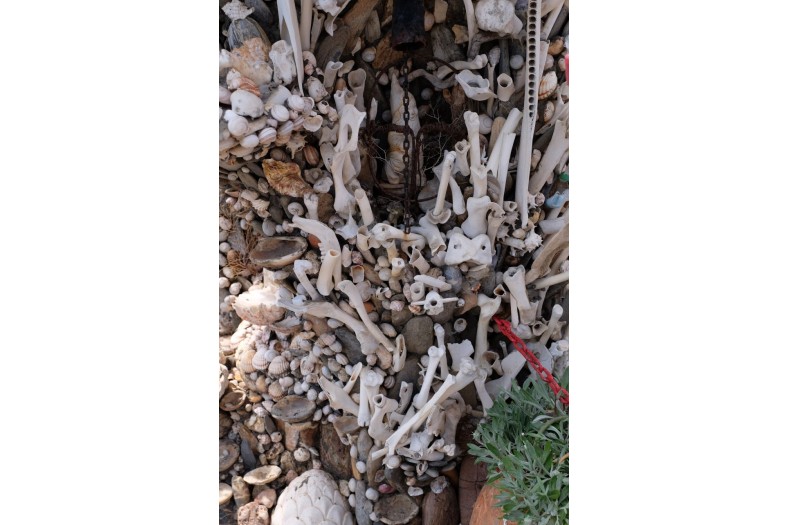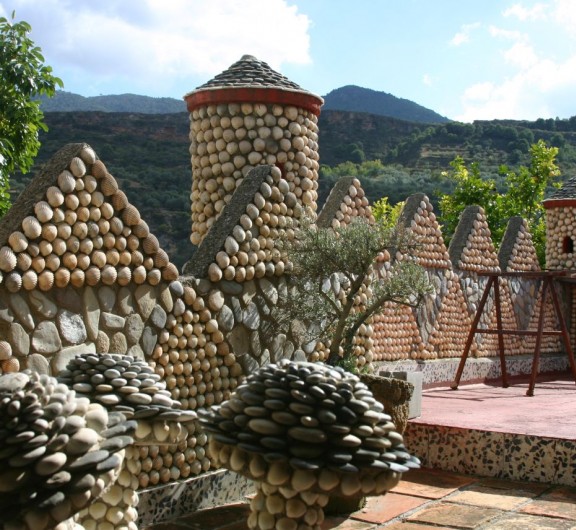Jardín / GardenMaría Asunción Rodríguez Rodríguez (1936 - 2017)
Extant
Guainos Bajos, Andalucía, 04778, Spain
begun mid-1980s
Most of the garden is viewable from the beach.
About the Artist/Site
Born into a family of farmers, María Rodríguez grew up near the shores of the Mediterranean Sea, in an area now renowned for the enormous greenhouses of Almeria province that shelter the quantities of vegetables and fruits that feed Spain all year long. She had little schooling, mostly spending the days of her youth looking after her younger sister while her mother was working with her father in the fields. She married a local farmer when she was twenty years old, and afterward the young couple moved into a beachfront home that her father had previously purchased. They worked hard to refurbish it, and appointed in the style of the last century, mostly with family furnishings: dark carved wood furniture, doilies, and vintage chandeliers.
Her married life followed a typical pattern; she cared for her three sons and her husband, kept the house, and did the shopping and the cooking. But she had always harbored the idea of creating something through which she could express herself, so she turned over ideas in her mind as she raised her boys and kept house. Finally, after they were grown, she began to build her garden in the mid-1980s. She never created drawings, but she saw the completed pieces in her mind – she describes these ideas as “maps” – so she just started building. She began assembling the stones and shells and found objects that she gathered from the beach, building up a “fence” in front and then filling in from that border to the very steps of the constructed front patio of her home; her idea was to surround the property with her artwork. A narrow pathway leads from her front door through the garden directly to the beach itself.
As she remembered watching her father build small structures as a young girl, she knew that she needed to use a mortar comprised of cement and sand, and that there always had to be more of the former and less of the latter. She seemed to viscerally understand the importance of the relative quantities of her mixture, and never had anything fall apart or crumble as a result of incorrectly-mixed mortar. She would mix small batches in a bucket, then mount one of her three step-ladders (low, medium, and high), her apron pockets full of stones and ornaments and her two hands cupping the mortar paste. After the first installation of the base level of stones, she would add more small ornaments and shells with silicon, enhancing the complexity and density of the site. Despite this balancing act, she never fell. Now in her 80th year, while she continues to work, she will only mount the shortest stepladder, as she has circulation problems in her legs that affect her balance and strength.
She continued working each morning and afternoon, sandwiching her “garacho [labors]” between shopping and cooking lunch for her family. Little by little, her garden grew more and more dense as it also grew higher. She calls the more vertical components that anchor different corners of the garden her “trees;” these complement lower sections with seating areas (also made of stone). These stone “chairs” tend to be on the perimeters, however, because the interior of the two side garden areas that front her house are compacted so tightly that it is impossible to enter them without stepping on and jumping over the sculptures, something that is not recommended. A variety of carefully-painted signs, mostly with proverbs or well-known phrases, underscore her interests and the rather secularized spirituality that she manifests.
With her constructions daily taking place right on the beach, naturally they are visible to all. Yet people respect her work, she says, and she hasn’t had problems either from passersby or municipal or coastal regulators. There is little tourism here, with most visitors heading east beyond Almeria or west toward Málaga and Marbella, so there has been little if any theft. But the assemblages are tempting to children, in particular, so Rodríguez has installed signs cautioning them not to touch. In general, however, she receives nothing but praise and positive reinforcement from her family, her neighbors, and those passersby with whom she talks.
María Rodríguez is secure in the knowledge that her garden will endure forever, although her children are not as certain. None of them have ever helped her place any work (nor have her five grandchildren); they all know it is her domain. As necessary, however, family members or friends will help her drag large stones or boulders into place, sometimes securing them with a cord or chain and dragging them with their cars. It is unclear, however, how much effort they will expend to maintain it after her passing.
While she is gracious and willing to talk to visitors and answer questions, she never believed that her garden would really be of interest to anyone except herself and she is still rather surprised at the visits. She doesn’t consider herself an artist, nor does she really consider her work to be sculpture; “I do what I do because I like it and because it relaxes me,” she states. But she is delighted when people appreciate what she does, and is clear that it inspires her to create more and more.
Most of the garden is viewable from the beach, and María Rodríguez is happy to answer questions (in Spanish) if she is around and working.
~Jo Farb Hernández, 2016
Update, 2017: María Rodríguez passed away September 26, 2017. The future of her site is unclear.
Contributors
Map & Site Information
Guainos Bajos, Andalucía, 04778
es
Latitude/Longitude: 36.7466345 / -3.0713197
Nearby Environments























Post your comment
Comments
No one has commented on this page yet.